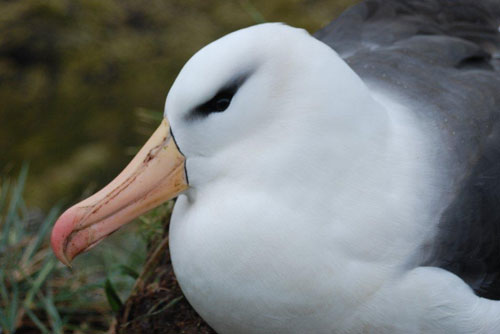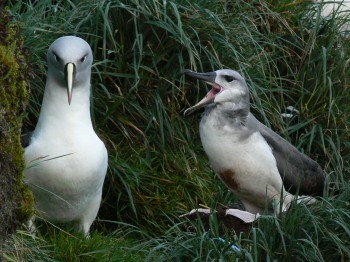The Black-browed Albatross Thalassarche melanophris of the Southern Ocean and the North Pacific’s Black-footed Albatross Phoebastria nigripes are no longer considered globally threatened by BirdLife International and the IUCN Red List. Previously categorized as Endangered and Vulnerable, respectively, they both now appear on the 2103 Red List update as Near-threatened (click here). In contrast the Grey-headed Albatross T. chrysostoma has been up-listed from Vulnerable to Endangered.
The following justifications for the changes are taken from the latest BirdLife fact sheets for each species:
Black-browed Albatross
This species has been downlisted to Near Threatened as it is no longer estimated to be undergoing very rapid population declines. Survey data from the Falkland Islands (Islas Malvinas)*, holding over 70% of the global population, showed population increases during the 2000s and possibly since the 1980s, and the data suggest reclassification as Least Concern, however there remains a considerable degree of uncertainty over population trends for a significant part of the global population, and trend estimates are heavily influenced by the extrapolation over 65 years of data from a ten-year period. In addition, high levels of mortality of this species are reported from longline and trawl fisheries in the South Atlantic. For these reasons, moderately rapid ongoing declines over three generations since 1980 are precautionarily [sic] suspected until further data are forthcoming.

The Black-browed Albatross is doing better...
Photograph by Genevieve Jones
Black-footed Albatross
This species has been downlisted from Vulnerable as analysis of recent data suggests that its population is not undergoing rapid on-going declines and is either stable or increasing. However, modelling of the likely effects of mortality caused by longline fishing fleets, combined with potential losses to breeding colonies from sea-level rise and storm surges, suggests it is appropriate to precautionarily [sic] predict a moderately rapid population decline over the next three generations (56 years), hence its classification as Near Threatened rather than Least Concern.
According to Birdlife “[t]here is still some way to go, but this gives us great hope for turning around the fortunes of other albatrosses. Bycatch in fisheries is the main threat, and efforts are underway in many longline and trawl fleets worldwide to reduce the numbers killed. If we can keep this up, there is real hope that the Black-browed and Black-footed Albatross will set a trend for the future.”
Grey-headed Albatross
This species has been uplisted to Endangered as data from some major colonies, in particular South Georgia (Georgias del Sur)*, which holds around half the global population, suggest that overall declines are taking place at a very rapid rate over three generations (90 years), even if colonies lacking trend information are assumed to be stable. The major driver of declines is likely to be incidental mortality on longline fisheries.

...but the Grey-headed Albatross is doing worse
Photograph by Marienne de Villiers
Meanwhile, decisions to down-list two other ACAP-listed species, the White-capped Albatross T. steadi (currently Near Threatened) and White-chinned Petrel Procellaria aequinoctialis (Vulnerable) are being held over until next year. A further ACAP-listed species, the currently Near Threatened Grey Petrel P. cinerea, has been proposed for down-listing but as yet no decision to review the species has been taken by BirdLife International.
Click here for an earlier news item on the recategorization of ACAP-listed albatrosses and petrels
John Cooper, ACAP Information Officer, 04 December 2013
*A dispute exists between the Governments of Argentina and the United Kingdom of Great Britain and Northern Ireland concerning sovereignty over the Falkland Islands (Islas Malvinas), South Georgia and the South Sandwich Islands (Islas Georgias del Sur y Islas Sandwich del Sur) and the surrounding maritime areas.

 English
English  Français
Français  Español
Español